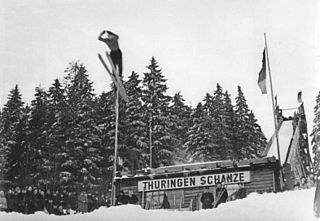
Simon Ammann is a Swiss ski jumper. He is one of the most successful athletes in the history of the sport, having won four individual Winter Olympic gold medals in 2002 and 2010. His other achievements include winning the 2007 Ski Jumping World Championships, the 2010 Ski Flying World Championships, the 2010 Nordic Tournament, and the 2010 Ski Jumping World Cup overall title.

Jens Weißflog is an East German and later German former ski jumper. He is one of the best and most successful ski jumpers in the history of the sport. Only Finns Matti Nykänen and Janne Ahonen, Poles Adam Małysz and Kamil Stoch and Austrians Gregor Schlierenzauer and Stefan Kraft have won more World Cup victories.

Thomas Morgenstern is an Austrian former ski jumper who competed from 2002 to 2014. He is one of the most successful ski jumpers of all time, having won the World Cup overall title twice with 23 individual wins, the Four Hills Tournament and the Nordic Tournament once each, eight World Championship gold medals, and three Winter Olympic gold medals.

Stanisław Marusarz ; 18 June 1913 – 29 October 1993) was a Polish Nordic skiing competitor in the 1930s.
Masahiko Harada is a Japanese former ski jumper. He is best remembered for a meltdown at the 1994 Winter Olympics in Lillehammer, which cost the Japanese national team a victory, and his subsequent redemption at the 1998 Winter Olympics in Nagano; the latter of which led to him being affectionately called "Happy Harada".

Armin Kogler is an Austrian former ski jumper.

Dieter Thoma is a West German/German former ski jumper.
Karl Schnabl is an Austrian former ski jumper who competed during the 1970s.

Anton Innauer is an Austrian former ski jumper.

Michael "Michi" Uhrmann is a German former ski jumper who competed from 1994 to 2011.
Hans Wallner is an Austrian former ski jumper.

Schonach im Schwarzwald is a town in the district of Schwarzwald-Baar in Baden-Württemberg in Germany.

Eric Frenzel is a German former nordic combined skier and current discipline coach for the German nordic combined team.

Peter Prevc is a Slovenian former ski jumper. He won the 2016 Ski Jumping World Cup overall title and four Olympic medals, including gold at the 2022 Winter Olympics in the mixed team event. He also won the 2016 Four Hills Tournament, 2016 Ski Flying World Championships, and three consecutive Ski Flying World Cup overall titles. In addition, Prevc won two team events with the Slovenia national team at the Ski Flying World Championships, in 2022 and 2024.

Srednja Bloudkova was a ski jumping K90 hill located in Planica, Slovenia, that existed between 1949 and 2012.
For the 1924 Winter Olympics in Chamonix, France, a total of three sports venues were used. The main stadium was used for all but two sports and part of a third. It was the first ski jump used for the Winter Olympics. A bobsleigh track was prepared for use.

Richard "Richi" Freitag is a German former ski jumper who competed at World Cup level from 2010 to 2022. He was runner-up in the overall 2017–18 Ski Jumping World Cup, and won the bronze medal at the 2018 Ski Flying World Championships.

Andreas Wellinger is a German ski jumper. His career-best achievements include an individual gold and silver medal at the 2018 Winter Olympics. He also won a team gold medal at the 2014 Winter Olympics and a team silver medal at the 2018 Winter Olympics, mixed team gold at the 2017 and 2023 Ski Jumping World Championships, an individual silver medal at the 2017 and 2023 World Championships and individual silver medal at the 2024 Ski Flying World Championships.

The 21st annual Four Hills Tournament was won by East German athlete Hans-Georg Aschenbach. After a dominating victory at the first event in Oberstdorf, and three more podium finishes, he ended up with a 43-point lead over second-placed Walter Steiner, who became the first Swiss to win a Four Hills event in Garmisch-Partenkirchen.

Thüringenschanze or Thuringia ski jump, known as Hindenburg ski jump until 1945, was a ski jumping hill in Oberhof in the Thuringian Forest. The large hill, which was built between 1925 and 1927, was one of the largest ski jumps in Germany for over 50 years in terms of jump distances. It was located on the western slope of the Wadeberg next to the youth ski jump on the outskirts of Oberhof. It hosted the ski jumping competitions of the Nordic World Ski Championships in 1931 and numerous other ski jumping competitions with international participants. The construction point (K-point), the size for which a ski jump is designed, was last at 82 meters after several conversions and extensions and the hill record, set by Jens Weißflog in 1981, was 83.5 meters. It was demolished in 1986.
















